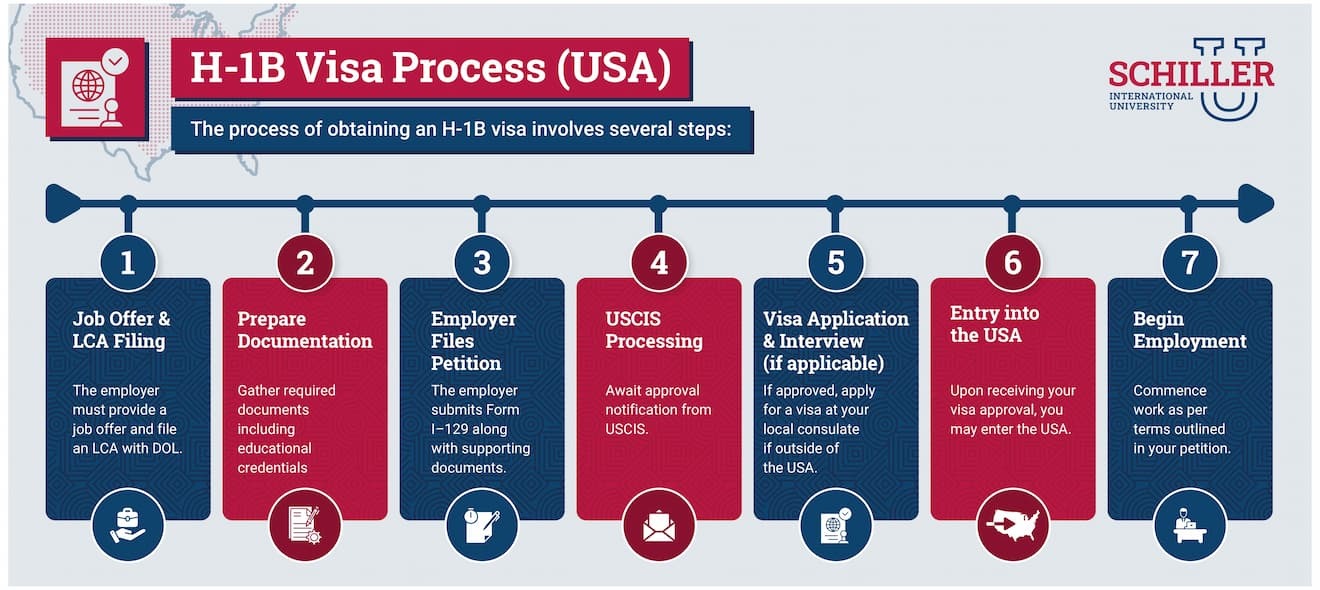 News
News
The H-1B visa implications landscape is shifting fast, and the new $100,000 fee has left U.S. employers scrambling for alternatives. As restrictions tighten, many companies are rethinking how and where they build their tech teams. Instead of relying on costly visa-dependent hires, businesses are now embracing nearshore development, a smarter, faster, and more flexible way to access top-tier talent. With advanced technology, aligned time zones, and strong data security standards, nearshoring is quickly becoming the go-to solution for companies looking to stay competitive and compliant while avoiding the heavy costs and delays tied to the H-1B program.
H-1B Visa Implications Program Faces H1B Visa New Restrictions and Rising Costs
A Stark New Fee: $100,000 per Petition.
On September 19, 2025, President Trump signed a Presidential Proclamation titled “Restriction on Entry of Certain Nonimmigrant Workers”, effective September 21 at 12:01 a.m. EDT. Under this order, U.S. employers must pay a $100,000 supplemental fee for new H-1B petitions filed on or after the effective date if the beneficiary is outside the U.S. This surcharge is meant to discourage what the administration considers misuse of the program and to ensure that only top-tier talent benefits from it.
Who’s Impacted (and Who’s Not).
New visa applicants outside the United States will be affected first. Their petitions must include the $100,000 fee to be approved. Existing H-1B holders, as well as extensions, renewals, and transfers, are reportedly exempt according to recent government clarifications. However, uncertainty remains for those who travel abroad and seek re-entry after September 21, with officials advising caution. The restriction is currently set to last for 12 months, though it could be extended or replaced in the future.
Legal Pushback Begins.
The response has been immediate. The U.S. Chamber of Commerce has filed a lawsuit arguing that the $100,000 fee exceeds executive authority and violates existing immigration law. Tech firms, universities, and healthcare organizations are also contesting aspects of the policy, pointing to its legal and economic consequences. If the courts intervene, the new rule could be paused or overturned, maintaining the current H-1B framework for now.
What This Means in Practice.
For employers, the new fee represents a major financial burden. A $100,000 cost per H-1B hire could prevent smaller companies from participating in the program altogether. Many organizations may instead turn to nearshore or offshore hiring models to bypass these costs. There are also discussions about changes to the lottery system that could favor higher-paid positions and limit exemptions. Overall, the current environment is filled with uncertainty, as conflicting statements from different government offices have created confusion among employers and applicants alike.
What to Watch Next
The coming months will be critical for employers, developers, and global hiring teams observing the evolving H-1B landscape. With uncertainty surrounding the new proclamation, several areas deserve close attention.
1. Court Rulings and Legal Outcomes.
The U.S. Chamber of Commerce and several major tech companies have already filed lawsuits. If the courts decide that the $100,000 fee exceeds presidential authority, the proclamation could be blocked, delayed, or modified. However, if the courts uphold it, the new fee structure may become a lasting part of the H-1B process. Companies that depend on international tech talent are following these developments closely since the verdict will determine whether cross-border hiring remains viable or becomes much more limited.
2. Final Rules from Immigration Authorities.
The Department of Homeland Security and the Department of Labor are expected to release detailed instructions soon. These updates will define how the rule will be implemented, which industries or visa categories are exempt, and what compliance steps employers must take. The official guidance will determine how the policy works in practice and what businesses need to prepare for in upcoming filing seasons.
3. The Future of the H-1B Lottery.
There is growing speculation about reforming the H-1B visa consequences and the lottery system to favor higher salaries or more specialized job roles. If this happens, large corporations may gain a stronger advantage over startups and smaller companies. Such a change would influence how employers plan recruitment and how global professionals decide where to build their careers in the United States.
4. Cap-Exempt Clarifications.
Universities, nonprofits, and medical institutions are waiting for clarification on whether the new restrictions and fees will apply to them. These organizations have traditionally been exempt from certain H-1B limits and additional charges, but the new policy has created confusion. The outcome of this clarification will significantly affect sectors like education, healthcare, and research that depend on international expertise.
5. Duration and Long-Term Impact.
The proclamation is currently set to last for 12 months, but many believe it could be extended depending on political and economic factors. The administration has not dismissed the idea of making this rule permanent or including it in a broader immigration reform. Companies should plan for both possibilities: a short-term disruption or a long-term restructuring of the H-1B system.
6. Strategic Shifts in Hiring.
Faced with rising costs and regulatory uncertainty, many businesses are rethinking how they access global talent. Nearshore hiring, remote teams, and outsourcing to Latin American or regional markets are becoming increasingly attractive. Instead of relocating skilled professionals through the H-1B program, many companies are now focusing on bringing their projects to where the talent already exists.
How Nearshore Solutions Are Rising in Relevance
→ AI and Automation Are Filling the Skill Gaps.
With the tightening of H-1B regulations, U.S. companies are turning toward nearshore partners that leverage AI-driven tools for faster software delivery. Nearshore teams in Latin America are now integrating AI-assisted coding, automated testing, and continuous deployment pipelines to accelerate production cycles. These innovations make it possible to scale teams instantly and maintain productivity without depending on visa approvals. The use of intelligent development assistants and automated QA systems has become standard, allowing developers to work smarter, reduce human error, and shorten release times dramatically.
→ Hybrid Team Models Are Becoming the New Normal.
The traditional separation between remote and onsite work is fading. Companies are adopting hybrid team models that combine U.S.-based managers or leads with full nearshore development squads. This structure provides real-time collaboration, agile flexibility, and cultural compatibility. It also supports on-site visits, project sprints, and co-development sessions that align perfectly with North American work hours. As a result, firms can maintain innovation momentum while avoiding immigration and relocation barriers that come with H-1B limitations.
→ Security and Compliance Are Non-Negotiable.
With data protection laws becoming stricter, nearshore partners are prioritizing cybersecurity and compliance as a key element of their value offering. Many have adopted advanced standards for data encryption, access management, and information governance. This is especially critical for U.S. clients in industries such as fintech, healthcare, and eCommerce, where data integrity and IP protection are essential. The new security focus has transformed nearshore outsourcing into a reliable and trustworthy model for international collaboration.
→ Niche Technical Roles Are Driving New Demand.
There’s a growing demand for specialized technical roles that go far beyond traditional development. AI engineers, data scientists, cloud architects, and cybersecurity experts are among the most sought-after professionals. Nearshore tech hubs in Latin America are now known for cultivating this advanced talent, offering skills that rival those found in major U.S. tech centers. Businesses are forming long-term partnerships with nearshore agencies that can deliver deep technical specialization while maintaining flexibility and cost efficiency.
→ Expansion into Emerging Nearshore Destinations.
While Latin America remains a strong nearshore region, new destinations are rapidly gaining traction. Countries such as Costa Rica, Uruguay, and several in Eastern Europe are emerging as attractive development centers. Companies are diversifying their nearshore presence to reduce risk and tap into new pools of expertise. This multi-location approach ensures operational continuity and allows for nearly round-the-clock progress on projects across time zones.
→ Ethical and Sustainable Partnerships Are Gaining Importance.
Sustainability and ethics have become key priorities in outsourcing decisions. Businesses are increasingly partnering with firms that uphold fair labor practices, support employee well-being, and emphasize diversity and inclusion. Many nearshore companies are also integrating environmentally conscious practices, reducing their carbon footprint, and promoting local community development. This trend reflects a growing awareness that outsourcing should align with both business goals and broader social responsibility.
→ Blending Technology with Human-Centric Collaboration.
One of the most significant shifts today is the rise of hybrid global teams that combine human expertise with AI-powered tools. Nearshore developers are working side by side with intelligent systems and local leadership to co-create advanced digital solutions. This approach maintains innovation, creativity, and adaptability while ensuring projects are delivered efficiently and ethically. The focus is no longer just on outsourcing but on building meaningful, long-term collaborations that drive real technological progress.
Why Blue Coding Can Be Your Nearshore Partner
The Blue Coding team has a full-proof method of dealing with the challenges that new H-1B restrictions bring to companies seeking global tech talent. That’s why we specialize in providing highly skilled nearshore development teams that deliver results without visa complications or unexpected costs. From AI-driven solutions to niche technical expertise, our teams are ready to integrate seamlessly with your in-house operations, ensuring speed, quality, and compliance. We’ve helped numerous clients scale projects efficiently while maintaining full control over timelines and budgets. Reach out to us today and we will book you a free strategy call to explore how we can support your business with the right nearshore strategy.




